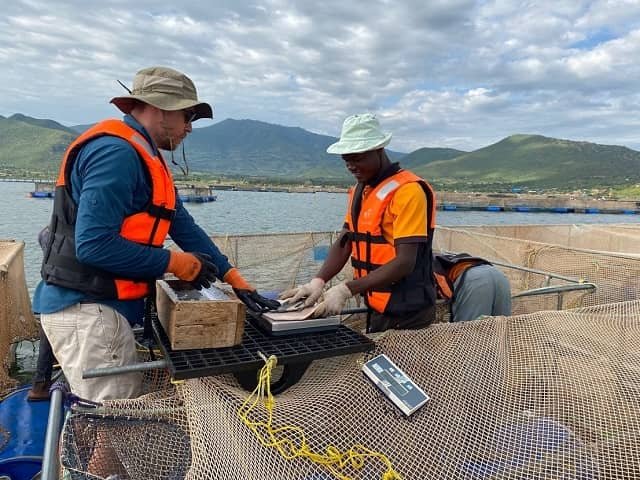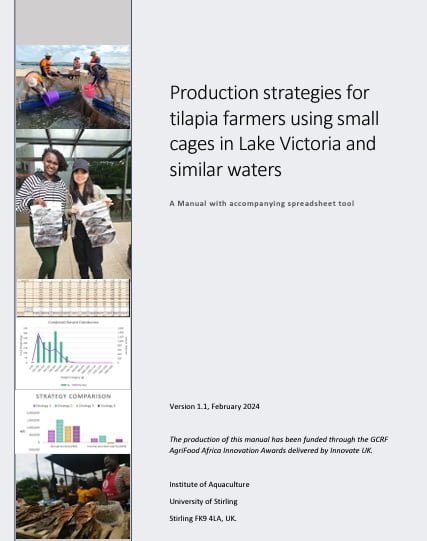
The flourishing aquaculture industry in Africa, particularly tilapia farming, is a significant source of food and nutrition. However, most fish farms focus on producing large fish for wealthier consumers. This overlooks a potential market: people who prefer or can only afford smaller tilapia.
To address this challenge, researchers from the Institute of Aquaculture at the University of Stirling (UK) and the Kenya Marine and Fisheries Research Institute (KMFRI) studied the potential of producing small tilapia in cages using shorter growth cycles and higher population densities. This study provides valuable insights for both fish farmers and policymakers.
A Missed Market Opportunity?
While large-scale fish farms prioritize maximizing fish weight, many African consumers actually prefer or can only afford smaller fish. This preference is driven by factors such as:
- Price: Smaller fish are cheaper.
- Culinary habits: Local recipes may be tailored for smaller fish.
- Portion sizes: Smaller fish are ideal for feeding families.
- Health benefits: Some believe whole small fish offer greater nutritional value.
Small Fish, Big Advantages for Fish Farmers
Raising smaller tilapia offers several benefits for both fish farmers and consumers:
- Faster cash flow: Shorter production cycles mean quicker sales and income.
- Lower feeding costs: Smaller fish require less feed, improving profitability.
- Sustainability: Reduced feed usage translates to lower environmental impact.
- Improved nutrition: Consuming whole small fish may provide more micronutrients.
- Reduced risk: Smaller fish are less susceptible to theft and weather events.
Challenges and Solutions: Population Density and Partial Harvests
Raising smaller tilapia requires adjustments in traditional fish farming practices:
- Population density balance: While higher population density may increase overall biomass production, it can also slow growth and decrease survival rates. Finding the optimal population density for producing smaller fish is crucial.
- Partial harvests: Regularly harvesting some fish throughout the production cycle allows for better cash flow, reduces competition for food among remaining fish, and potentially improves growth rates. This approach is already used in many small-scale African farms.
A Case Study: Nile Tilapia in Lake Victoria
The article highlights a study conducted in Kenya that investigated the feasibility of producing smaller Nile tilapia in cages in Lake Victoria. The research aimed to evaluate:
- Biological potential: Growth rates, survival rates, and overall fish health under a smaller fish production strategy.
- Financial potential: Profitability of this approach compared to traditional larger-scale fish production.
The study involved an experiment with three treatment groups and six replications each. Here’s a breakdown:
- Treatment 1 (T1): Standard density (2.9 kg/m³) targeted for fish with an average weight of 400 grams (g) after 138 days (achieved: 500.33 g).
- Treatment 2 (T2): Doubling the density (5.9 kg/m³) intended for 400 g fish in 138 days (achieved: 439.22 g).
- Treatment 3 (T3): Partial harvest (50%) at 76 days (average weight: 230.92 g), remaining fish cultured for another 62 days (final average weight: 499.86 g).
Key Findings: Balancing Efficiency and Profits
- Population density: Doubling the population density (T2) did not significantly affect growth rates or feed conversion ratios compared to standard density (T1). This suggests that farmers can potentially increase production without harming fish health.
- Partial Harvest: T3, with its partial harvest, achieved a lower feed conversion ratio than the other treatments. However, it also had the lowest overall production due to smaller fish size at harvest time.
- Financial performance: Treatment 2 (T2) achieved the highest gross margins due to higher overall production without sacrificing fish size. This indicates that higher population density can be profitable.
- Small tilapia market: While T3 had lower margins, the smaller fish size could be more appealing to certain consumers willing to pay a lower price per kilogram. Additionally, a model scenario (M1) simulating a full harvest at 76 days with small fish resulted in negative margins, suggesting this approach may require further market exploration.
New Tool: Spreadsheet Model for Production Strategies
The researchers have developed a spreadsheet model to assist tilapia farmers and extension workers in evaluating various cage production strategies in tropical lakes. This model is particularly useful for exploring strategies involving producing a higher proportion of smaller fish for price-sensitive consumers. It can also be used as an educational tool to help focus on different aspects of cage farm management.
Important Considerations
It’s worth noting that the model, using mathematical models, should not be considered an exact prediction of aquaculture production or financial performance. However, users can adjust many variables based on their knowledge and experience, making it a valuable tool for generating ideas and conducting further experiments.
Model Features
The spreadsheet model simulates tilapia growth in one or more cages over a user-defined period. It provides estimates of production volumes, fish sizes, and feed consumption. By inputting basic farming costs and selling prices, the model also indicates financial returns. Up to four production scenarios can be compared and combined to develop an overall strategy. Scenarios include the option to partially harvest a cage to produce an early harvest of smaller fish.
User Guide and Tutorials
While the spreadsheet is designed to be user-friendly, it requires some complexity to adapt to different circumstances. Therefore, the researchers have produced a manual to accompany the spreadsheet, providing more details on its use, underlying considerations, and principles. Additionally, there is a set of video tutorials available on YouTube.
Overall, this spreadsheet model offers a valuable tool for tilapia producers and extension workers to explore and evaluate different production strategies, potentially leading to improved productivity, profitability, and market access.
Download Links
Tilapia Production Spreadsheet (v1.1) (Excel)
Tutorial Videos (YouTube Playlist)
Manual: Bostock, J., Pounds, A., Kaminski, A., Nguyen, T & Little, D. 2023. Production strategies for tilapia farmers using small cages in Lake Victoria and similar waters. Manual & Spreadsheet. University of Stirling.

The big picture: Inclusive and Nutritious Aquaculture
By producing smaller and more affordable tilapias, aquaculture can become:
- More inclusive: Serving a broader range of consumers, especially low-income populations.
- More nutrition-sensitive: Providing essential animal protein to those who need it most.
This approach aims to make aquaculture a tool for achieving food and nutritional security for all.
Conclusion
By exploring the production of smaller tilapias, the aquaculture industry in Africa can become more inclusive and contribute to better food security:
This research highlights several key points:
- African fish farmers can benefit from increased population density.
- Partial harvesting and shorter cycles can generate faster cash flow, ideal for small-scale farmers.
- While these approaches yield smaller fish with potentially lower profit margins per kilogram, they cater to a wider market segment.
- Small-scale tilapia production can improve affordability and accessibility for low-income consumers.
The study was funded by Nutreco and Tunga Nutrition and conducted at Victory Farms Ltd.
Contact
Alexander M. Kaminski
Institute of Aquaculture, University of Stirling
Stirling FK9 4LA, UK
Email: a.m.kaminski@stir.ac.uk
Reference (open access)
Wang, H., Wang, Y., Xu, K., Pan, S., Shi, W., & Wang, X. Changes in water-soluble taste compounds of tilapia (Oreochromis niloticus) fillets subjected to different thawing methods during long-term frozen storage. Journal of the Science of Food and Agriculture. https://doi.org/10.1002/jsfa.13542
Editor at the digital magazine AquaHoy. He holds a degree in Aquaculture Biology from the National University of Santa (UNS) and a Master’s degree in Science and Innovation Management from the Polytechnic University of Valencia, with postgraduate diplomas in Business Innovation and Innovation Management. He possesses extensive experience in the aquaculture and fisheries sector, having led the Fisheries Innovation Unit of the National Program for Innovation in Fisheries and Aquaculture (PNIPA). He has served as a senior consultant in technology watch, an innovation project formulator and advisor, and a lecturer at UNS. He is a member of the Peruvian College of Biologists and was recognized by the World Aquaculture Society (WAS) in 2016 for his contribution to aquaculture.
